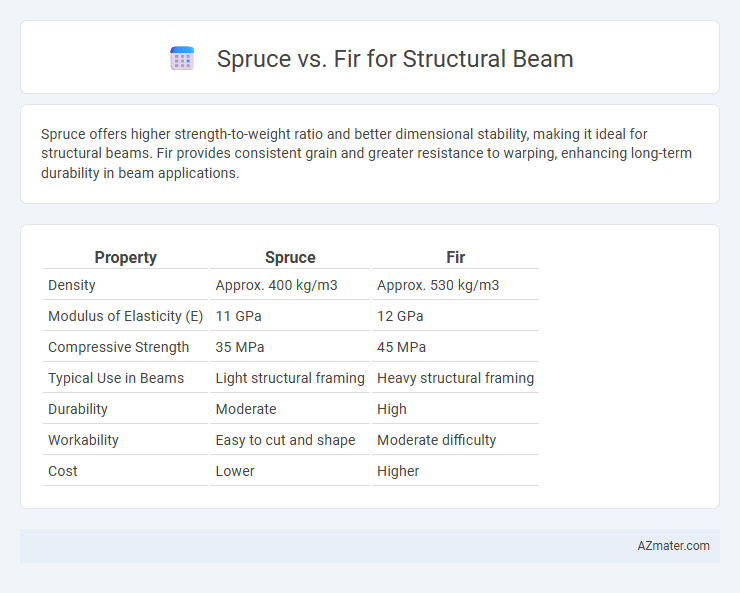Spruce offers higher strength-to-weight ratio and better dimensional stability, making it ideal for structural beams. Fir provides consistent grain and greater resistance to warping, enhancing long-term durability in beam applications.
Table of Comparison
| Property | Spruce | Fir |
|---|---|---|
| Density | Approx. 400 kg/m3 | Approx. 530 kg/m3 |
| Modulus of Elasticity (E) | 11 GPa | 12 GPa |
| Compressive Strength | 35 MPa | 45 MPa |
| Typical Use in Beams | Light structural framing | Heavy structural framing |
| Durability | Moderate | High |
| Workability | Easy to cut and shape | Moderate difficulty |
| Cost | Lower | Higher |
Introduction to Spruce and Fir Structural Beams
Spruce and fir structural beams are widely used in construction due to their strength-to-weight ratio and workability. Spruce offers lightweight properties with consistent grain and good load-bearing capacity, making it ideal for framing and roof structures. Fir provides high strength, stiffness, and durability, often preferred for beams requiring longer spans and heavy load performance.
Wood Species Overview: Spruce and Fir
Spruce and fir are popular wood species for structural beams due to their strength-to-weight ratio and availability. Spruce, primarily Picea abies, offers a high stiffness and good load-bearing capacity, commonly used in North American and European construction. Fir, especially Douglas fir (Pseudotsuga menziesii), is known for superior dimensional stability, resistance to splitting, and excellent tensile strength, making it ideal for heavy framing and structural support.
Strength and Structural Performance Comparison
Spruce and fir both serve as popular choices for structural beams due to their favorable strength-to-weight ratios and consistent performance under load. Spruce typically offers slightly higher tensile strength and stiffness, making it more suitable for applications demanding superior load-bearing capacity and rigidity. Fir, while slightly less strong, provides excellent dimensional stability and resistance to warping, which enhances long-term structural integrity in varying environmental conditions.
Weight and Density Differences
Spruce beams typically have a density around 350 to 450 kg/m3, making them lighter and easier to handle compared to fir beams, which range from 400 to 550 kg/m3. The lower weight of spruce can reduce the overall load on a structure, beneficial in seismic or weight-sensitive constructions. Fir's higher density translates into greater strength and stiffness, making it more suitable for beams requiring enhanced load-bearing capacity.
Workability and Ease of Construction
Spruce beams are prized for their excellent workability due to their fine, even grain and lighter weight, making them easier to cut, drill, and nail on-site. Fir beams, while slightly denser, offer greater strength and dimensional stability but require more effort during handling and machining, impacting ease of construction. Both woods provide reliable performance, but spruce is often preferred for projects prioritizing faster assembly and simpler modifications.
Durability and Lifespan in Structural Use
Spruce and fir both offer reliable strength for structural beams, but fir generally outperforms spruce in durability due to its denser grain and higher resistance to decay and insect damage. Fir's natural resistance extends its lifespan in structural applications, often lasting several decades longer under similar conditions compared to spruce. Choosing fir can result in more durable and longer-lasting beams, especially in environments exposed to moisture or pests.
Cost Comparison: Spruce vs Fir Beams
Spruce beams generally offer a lower cost compared to fir beams, making them a budget-friendly option for structural applications without compromising basic strength. Fir beams, while slightly more expensive, provide superior durability and load-bearing capacity, which can result in long-term savings due to reduced maintenance and replacement costs. Cost comparisons should consider local availability and the specific structural requirements to determine the most economical choice between spruce and fir beams.
Sustainability and Environmental Impact
Spruce beams offer higher strength-to-weight ratios and faster renewable growth cycles, making them a sustainable choice for structural applications with lower carbon footprints compared to fir. Fir beams, while durable and widely used, tend to have slower growth rates, leading to longer carbon sequestration periods but potentially higher environmental impact due to extended harvesting intervals. Selecting spruce over fir can contribute to reduced deforestation and support responsible forestry management, enhancing overall building sustainability.
Common Applications in Building Projects
Spruce beams are widely used in residential framing and roof trusses due to their excellent strength-to-weight ratio and cost-effectiveness. Fir beams, particularly Douglas fir, are preferred for commercial and heavy-duty construction projects where higher structural load capacity and dimensional stability are crucial. Both species play integral roles in wood-frame construction, with spruce favored for lightweight applications and fir chosen for more demanding structural components.
Choosing the Right Timber: Spruce or Fir for Your Project
Spruce and fir are both popular choices for structural beams due to their strength-to-weight ratio and workability, but spruce often offers better stiffness and dimensional stability, making it ideal for load-bearing applications. Fir tends to have a higher resistance to decay and greater durability in outdoor conditions, which makes it suitable for projects exposed to moisture or weather. When choosing between spruce and fir, consider the specific structural requirements and environmental exposure of your project to ensure optimal performance and longevity.

Infographic: Spruce vs Fir for Structural Beam
 azmater.com
azmater.com